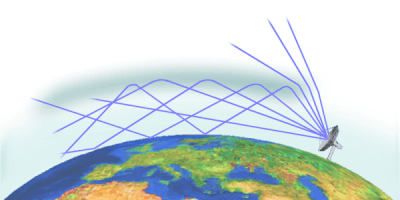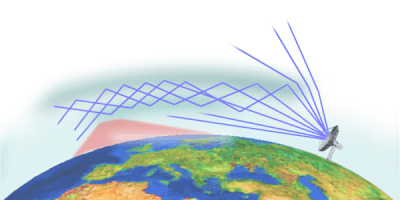Propagation of Electromagnetic Waves

influence
of refraction
refraction
Figure 1: The refractions influence on the range of the radiohorizon

influence
of refraction
refraction
Figure 1: The refractions influence on the range of the radiohorizon

influence
of refraction
Figure 1: The refractions influence on the range of the radiohorizon
Propagation of Electromagnetic Waves
The propagation of electromagnetic waves in a uniform and constant medium happens to quasi-optical laws. These conditions are relatively seldom in the earth atmosphere in practice.
Anomalous Propagation (Anaprop)
Non-standard or anomalous propagation (known as anaprop) occurs when the refractive index is modified by changes in temperature gradient, pressure or water vapour content. These parameters can give rise to a wide range of non-standard propagation conditions. One of the most common in Europe is temperature inversion, which occurs when heat radiates from the ground on clear nights. The ground temperature falls but the upper levels of the atmosphere remain comparatively warm - this temperature gradient being the reverse of the normal negative temperature gradient. The result of this temperature inversion is to duct the transmitted energy along the ground greatly extending the normal range of the radar.

Figure 2: Atmospheric inversion

Figure 2: Atmospheric inversion
Overreaches
The normal range of the radar is so greatly extended, that the echoes of the far away targets falls in the following pulse repetition period. Therefore the scope shows the targets in a wrong range.
Ducting
Under normal atmospheric conditions, the warmest air is found near the surface of the Earth. The air gradually becomes cooler as altitude increases. At times, however, an unusual situation develops in which layers of warm air are formed above layers of cool air. This condition is known as temperature inversion. These temperature inversions cause channels, or ducts, of cool air to be sandwiched between the surface of the Earth and a layer of warm air, or between two layers of warm air.

Figure 3: Ducting

Figure 3: Ducting
If a transmitting antenna extends into such a duct of cool air, or if the radio wave enters the duct at a very low angle of incidence, vhf and uhf transmissions may be propagated far beyond normal line-of-sight distances. When ducts are present as a result of temperature inversions, good reception of vhf and uhf television signals from a station located hundreds of miles away is not unusual. These long distances are possible because of the different densities and refractive qualities of warm and cool air. The sudden change in density when a radio wave enters the warm air above a duct causes the wave to be refracted back toward Earth. When the wave strikes the Earth or a warm layer below the duct, it is again reflected or refracted upward and proceeds on through the duct with a multiple-hop type of action. An example of the propagation of radio waves by ducting is shown in the figure.
Subrefraction
A reversal of the effect is also possible. Sub-reaches by diversion of the beam in direction of above affect not noticeable disturbing, however, so like an overreach. Radar coverage may also be lost at lower elevation angles.
| Refraction | gradient of the refractive index |
schematic representation |
conditions for the emergence |
| negative (sub-refraction) |
>0 |  |
snowfall, if the temperature reduced dependent of the height fundamentally fast, the humidity reduced fundamentally more slowly than in the normal atmosphere |
| none | 0 |  |
if the refractive index doesn't change in some height intervals |
| positive, low |
0 to -4·10-8 |
 |
rainy, cheerless weather, if the temperature reduced dependent of the height fundamentally fast, the humidity reduced more slowly than in the normal atmosphere |
| positive, normal |
-4·10-8 | cheerless weather, if the layers of atmosphere are mixed well.Corresponds to the normal atmosphere if the air temperature is reduced by 6.5 centigrades per kilometers of height and the pressure of the steam reduces by 3.5 mBar per kilometers of height | |
| positive, increased |
-4·10-8 to -17,5·10-8 |
Clear weather after sundown, if the air temperature is lower reduced dependent of the height, i.e. at starting temperature inversion. | |
| positive, critical |
-17,5·10-8 |  |
Clear weather after sundown at temperature inversion |
| Superrefraktion | less than -17,5·10-8 |
 |
At high barometric pressure and important temperature inversion as well as reduced atmospheric humidity. Important over the continent in night and morning hours, over the sea in clear weather whole days, if the air at the sea surface is colder and damper than in layers lain more highly |
Table 1: Classification of the refraction in the earth's atmosphere
